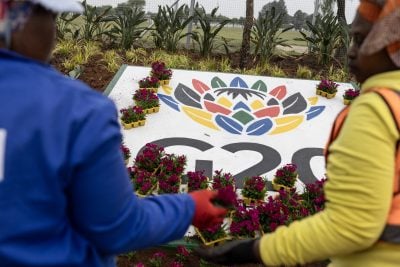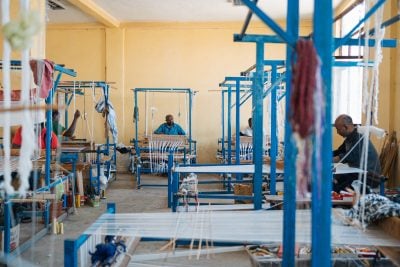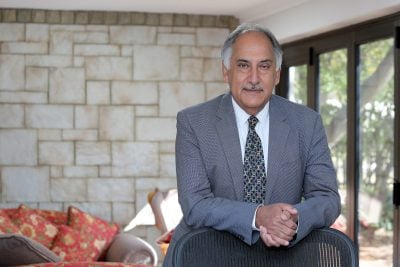How will Lagos’s projected 88m inhabitants go to work in 2100? Electric buses, high-speed tramways, automated cars? Far from the fanciful discourse of flying cars and aerospace railways, urban planners say the question of mobility in the future megacities of Africa – which will soon be among the largest cities in the world – needs a pragmatic approach.
While most of the world’s biggest cities are currently in Asia, Africa’s population is expected to reach 2.5bn in 2050, with the most significant growth occurring in urban areas as people migrate to cities in search of work.
Cities across Africa are already booming: In Nigeria and Ghana, more than half of the population now lives in cities. In East Africa, although countries are relatively less urbanised (30% in Rwanda, 26% in Kenya, 20% in Ethiopia), they have the highest urban growth rates on the continent.
“In Africa, urbanisation happens at an early stage of development. Cities are not as rich as Asian, European, and Latin American cities were when they went through strong urban growth,” says Philipp Rode, executive director at LSE Cities, a London-based international centre for urban studies.
African cities have specific structural features. As a consequence, the futures of Lagos, Kinshasa, Dar es Salaam, Khartoum, and Niamey look very different from today’s Tokyo, the world’s most populous city.
In the case of the African cities, many more variables need to be considered. African cities have different historical trajectories to their Asian, Western or South American counterparts, as most were built during colonial rule, influencing their spatial structures and urban environments. The challenge is enormous – affordability, reliability and accessibility for hundreds of millions of Africans must be improved amid an unprecented era of urban development.
Unprecedented sprawl
One challenge affecting African urban dwellers – who will number more than 900m in 2050 – is their cities’ unprecedented sprawling development. According to the World Bank, there is 20% more urban sprawl in African cities than in other cities in developing regions.
Traditional transport infrastructure cannot cope with such exponential and unrestricted urban growth. African municipalities need to either bring opportunities (work, healthcare centres, food markets) closer to where people live, or give them a faster way to commute. That will require a step-change in thinking for urban authorities across the continent who currently focus most of their attention on easing severe congestion problems – Lagosians, for example, spend at least three hours in traffic each day.
But there are increasing examples of policymakers grasping the nettle. In 2015, Addis Ababa opened sub-Saharan Africa’s first light railway. Last year, Dakar inaugurated its first regional express train, linking the city centre to the fast-growing suburb of Diamniadio.
Dar es Salaam, in Tanzania, has turned to an ambitious bus rapid transit (BRT) project as an alternative to the 5,200 privately owned dala dala buses which can’t handle the city’s urban growth. Maputo in Mozambique is mulling its own ambitious BRT scheme.
“The cable car project developed by Poma in Madagascar’s capital Antananarivo is another example of urban infrastructure that perfectly suits the city’s topography,” says Max Navarro-Roch, senior associate at Okan Partners, a strategy consulting firm.
Silencing the car horn of Africa
While pragmatic solutions are required, science fiction can also offer an inspiring guide to the future of mobility in African cities.
In a tweet, Janette Sadik-Khan,a former New York City Department of Transportation commissioner and now a principal at Bloomberg Associates, which advises mayors and their staff to help cities become stronger, safer, and healthier, celebrated the vision of Black Panther – the Marvel blockbuster set in a futuristic African society.
“Black Panther is one of the first movies to get urbanism right, with a transit-friendly, walkable Wakanda. The future will more likely have active streets, not just flying cars,” she wrote.
Indeed, walkability and integrated public transport systems are seen as increasingly essential urban characteristics. The automobile, which still rules the roost in many African cities, has suffered a backlash in recent years. Once a sign of modernity, its high carbon footprint means that its future is likely to be much more restrictive than its past.
According to the UN, cities are responsible for 75% of global CO2 emissions, with transport among the most significant contributors. Environmentalists say that Africa’s growing middle-class must shun the outdated cultural aspiration of privately-owned cars.
“In the US, it works because they completely accommodated their cities around private cars: spaces are privatised, and there is very little public life,” argues Rode. “African cities, rather, are full of public and communal life, which is simply incompatible with excessive car use.”
On-demand buses and vans
In 2020, the Addis Ababa Urban Age Task Force, a partnership between Addis Ababa’s municipality and LSE Cities, was created to identify strategic pilot projects to address a set of issues related to Addis’s rapid urban growth, which was 4.7% a year compared to the global average of 1.9% in 2020.
Among other key innovations, the task force came up with the idea of “digital van services,” which they describe as a range of on-demand shared-ride services using software to pool rides and optimise vehicle routing. On-demand buses could accommodate 10 to 20 people, provide access to Wi-Fi, and be more efficient by combining routes. “Digital vans” could encourage wealthy residents to shift to sustainable modes instead of buying their own vehicles and causing more pollution as they grow more prosperous, the task force argues.
Of course, shared vans and minibuses are not new to African city landscapes. Accra’s tro tros transport 70% of the city’s residents, making them the most widely used form of transportation in Ghana’s capital city. Minibus taxis are the default mode of transport for hundreds of millions in today’s African cities, offering affordability, convenience and a measure of reliability.
“One morning, I found out about a pool van service, run by someone who bought his own bus, which would take me to Lagos Island,” says Olusola Ikuforiji, an environmental advisor at the African Development Bank. “I did not even have a phone number; I just knew he would be at the junction of my street at a certain time in the morning.”
Minibuses nonetheless face challenges over vehicles’ roadworthiness. The 10-19 seat minibuses are usually second-hand vehicles of poor quality and contribute significantly to air pollution and road accidents. Moreover, minibuses in major African cities face a problem of regulation, as most of them are privately owned and operate with their own clients.
“I remember my parents had a bus when I was still living in Lagos,” says Ikuforiji. “It was another sort of avenue for making money at the time. You get a bus, a licence, and a driver who would return and deliver some funds to you.”
If “digital vans” are the future of mobility in Africa, digitalisation, regulation and vehicle modernisation will be required to usher the industry in a more sustainable direction.
What place for Uber-style ride-hailing?
If African cities are aiming for a carless society, the question of how ride-hailing companies will adapt is crucial.
In recent years, Uber and rival companies such as Bolt, Gett, Ola Cabs, Little Cab, Free Now, and Easy Taxi have all established African operations with varying degrees of success, attracted by widespread smartphone and mobile payment services adoption. They have focused on customer convenience and affordability, making hitherto distant parts of African cities without integrated public transport systems much more accessible.
In May, Uber recorded its billionth ride in Africa, having first established operations in 2013. Uber, which says it is active in over 50 cities on the continent, recently announced its expansion into eight new cities: Owerri and Akure in Nigeria; Eldoret, Kisumu, Nakuru and Naivasha in Kenya; and Tamale and Sunyani in Ghana.
The company has also launched new products and features in South Africa, Ghana, Kenya, Côte d’Ivoire and Nigeria. In August, the firm appointed Kagiso Khaole as its new general manager for sub-Saharan Africa, replacing the role of regional general manager for the Middle East and Africa.
“As we gear ourselves to mark our 10th anniversary next year, we are excited about moving into more cities enabling people to go anywhere and get anything. Our commitment to raising the bar on safety remains relentless and we continue to work hard to grow the over 3m earnings opportunities we have created thus far,” says Khaole.
However, not all policymakers are happy about the expansion of ride-hailing. There is evidence of increased traffic in cities where car-hailing companies operate, sparking environmental and congestion concerns.
“In the US and some parts of Europe, these services are eating into the public transport market,” says Rode.
Trips that would usually require public transport are shifting to ride-hailing services, increasing pollution and congestion, and exacerbating environmental challenges. However, Rode highlights the relevance of ride-hailing apps in fighting the culture of privately owned cars, which he identifies as the main threat to cities’ sustainable development.
“It helps foster a culture which is not about owning a car, but about mobility services, and that is a huge advantage,” he says.
African mobility startups redefine transport
Although foreign ride-hailing companies, such as Bolt (Estonia) and Uber (US) control a substantial share of the market, African mobility startups have been actively funded in recent years – culminating in more than $58.6m of investment by the end of 2021. Some replicate the Uber model, such as Halan in Egypt; others try to fit countries’ specific cultural contexts.
The Ugandan startup SafeBoda targeted the problem of unsafe trips by providing its riders with helmets and reflector jackets. SafeBoda also gives road safety training to its drivers in partnership with the Ugandan Ministry of Health.
According to the Global Innovation Fund, 160 deaths and 190 serious injuries were prevented between 2016 and 2020 as SafeBoda entered the market. The startup is an example of how to preserve a cultural habit while innovating.
“These new players will redefine transport in African cities, in a service mode, adapting to users’ needs and participating in the emergence of smart cities,” says Navarro-Roch.
Mobility startups are exploring an alternative to classic urban transportation, sometimes growing fast amid an unstructured environment. But there have been significant growing pains. In 2020, Lagos imposed a ban on motorcycle taxis following a spate of road accidents. At the time, the ban made 80% of the workforce of Gokada – a $12.45m funded motorcycle taxi startup – redundant.
Some policymakers fear the rise of unregulated startups and their contribution to congestion, and there are abiding concerns over driver conditions and the workability of the business model of global ride-hailing companies. A measure of regulatory control may need to be applied to ensure that the exciting growth of ride-hailing firms is managed in a sustainable way that works in harmony with planned urban development.
Financing: can cities go it alone?
African cities are booming in a strained environmental context. Although most have per capita emissions below their fair share of the global carbon budget, many are prone to climate disasters, including heatwaves, floods, landslides, and even coastal erosion.
“The increase in population and congestion, coupled with poor urban planning, ties into how African cities are vulnerable to climate change stresses,” says Ikuforiji.
Climate change challenges African cities in two ways: the need to limit greenhouse gas emissions and the need to construct reliable urban infrastructure. Resilient transport systems can take many forms. In the case of coastal cities, which are subject to sea level rises, infrastructure must be specifically designed. In Abidjan, for instance, the 37km aerial metro project, desiged to function during flooding, is part of such a model.
“In order to emerge, these models of resilience imply both a planning effort and the inclusion of all stakeholders from unions to residents and authorities,” says Navarro-Roch.
That highlights the essential need for greater funding. African cities need to unlock significant adaptation financing to climate-proof their expanding infrastructure, but almost all of the funding is taken up at the national level. Cities should be eligible to apply for adaptation financing without having to go through national governments, some believe.
“Right now, there is no place for sub-national financing mechanisms,” says Ikuforiji.
Municipalities should have more control of their finances in order to target the infrastructure that works best for them, says Philipp Heinrigs, senior economist at the OECD’s Sahel and West Africa Club.
“One of the best ways to unlock investment is to increase the fiscal capacity of municipalities. On the one hand, governments have to empower municipalities to raise revenues fiscally. On the other hand, they need to increase their political capacities for they have records in fiscal management and can then have the credibility to borrow on the market.”
The AfDB recently co-organised a trip to Copenhagen with representatives from several African municipalities (Nairobi, Tunis, Douala) focusing on people-centred urban development.
“African cities have an advantage compared to OECD cities as they still have the choice of technology they want to invest in,” argues Heinrigs.
But he points out that “the proposed solutions in terms of technology have to work in the context. You will probably not sell a lot of Teslas in Dakar in the next 20 years, but city planning in Africa will target mobility that fits the context.”
That context could prioritise green mobility. Addis Ababa, for example, has a high usage of “sustainable modes”, as 54% and 31% of daily trips are completed on foot and public transport, respectively.
However, “it is referred to as captive-walking, meaning that it takes much time, it is not convenient, and if people could choose, they will move to other modes,” explains Rode.
“We must get from captive-walking cities to choice-based walking cities, where people enjoy it,” he says.
Adaptation must take place fast
If African cities draw on other cities’ mistakes and adapt their city planning to their inhabitants’ current needs and cultural aspirations, they could invent new transport models that influence cities around the world.
“In Africa, you have the ingredients to almost leapfrog the cycle of urban development in which cities expand, motorise, and destroy their vibrant urbanity,” says Rode.
However, African mayors must be fast if they are to adapt: in the time it took to read this article, 13 people moved to Lagos.
Want to continue reading? Subscribe today.
You've read all your free articles for this month! Subscribe now to enjoy full access to our content.
Digital Monthly
£8.00 / month
Receive full unlimited access to our articles, opinions, podcasts and more.
Digital Yearly
£70.00 / year
Our best value offer - save £26 and gain access to all of our digital content for an entire year!
 Sign in with Google
Sign in with Google 



